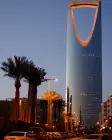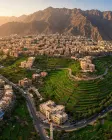How Is The Climate In Saudi Arabia?

How Is The Climate In Saudi Arabia? A Complete Guide to Weather and Seasons Across the Kingdom
Saudi Arabia’s climate is as bold and diverse as its landscapes. From the sweeping dunes of the Rub’ al Khali to the misty highlands of Asir, the Kingdom’s weather varies dramatically across regions. The climate in Saudi Arabia is predominantly desert — hot, dry, and sun-drenched — yet it carries surprising nuances depending on location and altitude. For travelers, adventurers, and those planning to explore the country’s treasures, understanding the climate in Saudi Arabia is crucial for an unforgettable journey.
Situated in the heart of the Arabian Peninsula, Saudi Arabia’s weather patterns are influenced by its vast topography and proximity to both the Red Sea and the Arabian Gulf. Summers are intensely hot, stretching from May to September, while winters, from November to February, invite cooler breezes and milder temperatures. The transitional months of March, April, and October offer the perfect balance — pleasant days and crisp nights, ideal for sightseeing and open-air adventures.
Whether you're wandering through ancient heritage sites like Madain Saleh (Hegra), exploring the futuristic skyline from the Sky Bridge at Kingdom Tower, or enjoying the tranquil breezes of Wadi Disah, the weather shapes every experience. Let’s dive into a detailed look at Saudi Arabia’s climate — from its summer extremes to its winter charm — so you can plan your adventure with confidence.
Saudi Arabia’s Desert Climate: Understanding the Basics
The climate in Saudi Arabia is classified as arid or desert, meaning rainfall is minimal and temperatures fluctuate widely between day and night. Average annual rainfall rarely exceeds 100 mm across most of the country. Daytime temperatures can soar past 45°C (113°F) in summer, especially in the interior deserts, while winter nights can drop close to freezing in elevated areas.
The lack of water bodies means humidity is generally low in central regions like Riyadh, though coastal cities such as Jeddah and Dammam can experience higher humidity levels due to the Red Sea and Arabian Gulf. This arid climate shapes not only the environment but also the traditional architecture, clothing, and lifestyle of Saudi communities, reflecting centuries of adaptation to the desert’s demands.
Seasonal Temperature Variations Across the Kingdom
Summers in Saudi Arabia are relentless. From May through September, the central and eastern deserts experience blistering heat, often exceeding 48°C (118°F). Air conditioning, shaded walkways, and evening travel become essential. In contrast, the mountainous southwest enjoys a milder climate, with regions like Abha and Taif offering daytime temperatures between 20°C and 30°C (68°F–86°F).
Winter brings respite. From late November to early March, cities like Riyadh and Hail see cool days averaging 20°C (68°F) and chilly nights dipping to 8°C (46°F). In rare cases, frost or even light snow falls in northern highlands near Tabuk and Jabal Al Lawz, creating stunning desert snowscapes.
Rainfall Patterns and Rare Storms
While Saudi Arabia is largely dry, sporadic rain showers and thunderstorms occur, particularly in spring and winter. The southwestern highlands receive the most rainfall, averaging 300 mm annually. These rains transform valleys like Hisma Desert into temporary green carpets, a rare but breathtaking sight. Flash floods, though infrequent, can occur in wadis (dry riverbeds), especially after intense storms.
Regional Climate Differences in Saudi Arabia
Saudi Arabia’s geography divides its climate into distinct zones. The central plateau around Riyadh experiences scorching summers and chilly winters. The western coast along the Red Sea, home to Jeddah and Mecca, enjoys a hot, humid climate with moderate winters. The eastern Gulf region mirrors this pattern but tends to be even more humid.
The Southwestern Highlands: A Mild Oasis
The Asir and Al Baha regions break the desert stereotype. At elevations above 2,000 meters, they enjoy cool breezes, misty mornings, and lush vegetation. Cities like Abha experience rainfall during summer months, a rarity in the Arabian Peninsula. The region is a popular summer escape for locals seeking relief from the desert’s heat. Nearby attractions such as Jabal Al Soudah and Asir National Park bloom with greenery, offering a refreshing alternative to Saudi Arabia’s arid heartlands.
Coastal Climates: Red Sea and Arabian Gulf
Along the Red Sea coast, Jeddah and Yanbu enjoy milder winters but steamy, humid summers. Sea breezes moderate the heat slightly, yet the combination of high humidity and temperatures around 40°C makes the air feel heavier. Despite that, coastal evenings are ideal for exploring spots like the Jeddah Corniche or the iconic King Fahd’s Fountain.
On the eastern seaboard, cities like Dammam share similar conditions with even higher humidity due to the Arabian Gulf. These coastal climates shape daily life — from clothing choices to work hours — reflecting the adaptability of Saudi society to its environment.
The Northern Landscape: Tabuk and Beyond
The northern areas, including Tabuk and Al Jawf, witness some of the most dramatic seasonal contrasts. Summers are warm and dry, while winters can bring frost, fog, and even snow. This region’s varying terrain — rocky plateaus and volcanic fields — creates microclimates that differ sharply from neighboring zones.
Southern Deserts and the Rub’ al Khali
The Empty Quarter, or Rub’ al Khali, is the world’s largest sand desert and one of Saudi Arabia’s most extreme environments. Daytime temperatures often surpass 50°C (122°F), while nights can drop sharply. Rain is almost nonexistent, and the landscape is defined by towering dunes and shifting sands — a true symbol of the desert climate in Saudi Arabia.
Best Time to Visit Saudi Arabia Based on Climate
For most travelers, the best time to visit Saudi Arabia is between November and March. During these months, temperatures are moderate, skies are clear, and outdoor exploration becomes truly enjoyable. Whether you’re visiting Diriyah in Riyadh or the archaeological wonders of Old Town AlUla, the climate is perfectly suited for sightseeing and photography.
Summer travel is possible but requires careful planning. Travelers flock to highland escapes like Abha or Taif for cooler weather. Coastal cities remain busy due to their vibrant nightlife and Red Sea leisure activities, including diving, snorkeling, and boating. For more insights, check the Best Time To Visit Saudi Arabia guide for seasonal tips and travel recommendations.
How Climate Influences Saudi Lifestyle and Culture
The Saudi lifestyle has long been intertwined with its environment. Traditional mud-brick architecture, wind towers, and covered courtyards evolved as ingenious responses to the desert’s heat. Even modern Saudi cities reflect this adaptation, with shaded boulevards and energy-efficient designs in places like the King Abdullah Financial District.
The climate also influences daily routines — early mornings and late evenings are preferred for outdoor activities, while midday hours are often reserved for rest or indoor gatherings. Festivals, such as those held in Riyadh or Jeddah during cooler months, attract massive crowds, celebrating the Kingdom’s cultural richness under pleasant skies.
Climate Change and Future Adaptation
Saudi Arabia is actively addressing the challenges posed by global climate change. Through initiatives like the Saudi Green Initiative, the country aims to reduce emissions, expand green spaces, and increase renewable energy use. The Kingdom’s Vision 2030 emphasizes sustainability, reflecting a growing awareness of how climate impacts both environment and economy.
Frequently Asked Questions About the Climate in Saudi Arabia
1. How hot does it get in Saudi Arabia during summer?
During summer, temperatures in central and eastern Saudi Arabia often exceed 45°C (113°F). Desert areas like the Rub’ al Khali can even reach 50°C (122°F). Coastal cities experience slightly lower temperatures but much higher humidity, making the heat feel more intense.
2. Does it ever snow in Saudi Arabia?
Yes, snow occasionally falls in northern highlands such as Tabuk and Jabal Al Lawz during winter. Though rare, these snowfalls create captivating scenes that contrast sharply with the desert’s arid reputation.
3. What’s the best time to visit Saudi Arabia for outdoor activities?
The best months for outdoor exploration are between November and March, when temperatures are mild and conditions are ideal for sightseeing, hiking, and desert tours. This period is also perfect for enjoying cultural events and visiting national parks.
4. How does the climate affect Saudi Arabian architecture?
The harsh climate shaped traditional Saudi design, leading to thick-walled homes, small windows, and shaded courtyards that retain cool air. Modern architecture continues this legacy, integrating sustainable materials and heat-resistant designs to conserve energy.
5. Which region in Saudi Arabia has the best weather year-round?
The Asir region, especially Abha and Al Baha, enjoys the most pleasant year-round climate. Thanks to its elevation, temperatures remain moderate even during summer, making it a preferred destination for both locals and tourists seeking cooler conditions.




